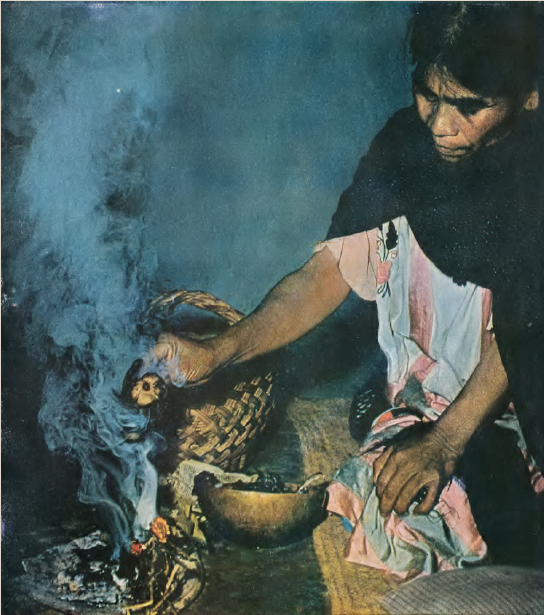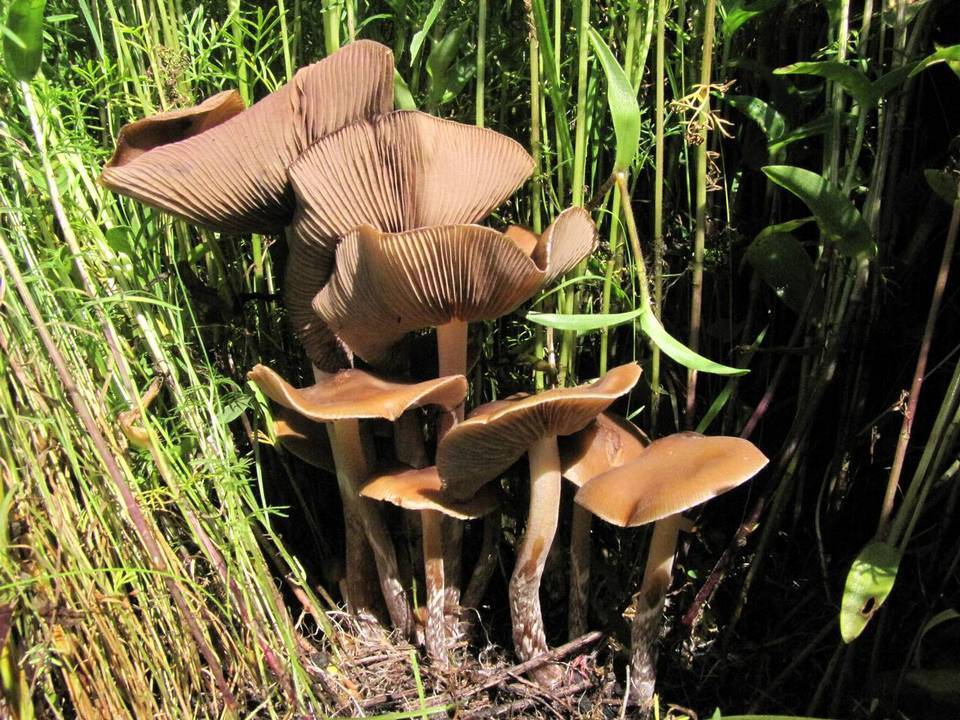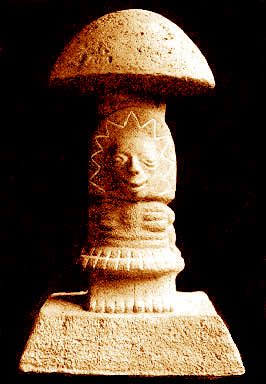
Wise-woman Maria Sabina pictured on the cover of LIFE Magazine in 1957

A pre-colonial illustration pictured in the 1957 LIFE Magazine article
In Huautla, Mexico, where the Mazatec tribe of indigenous Mexicans reside, there are at least six psilocybin-containing species growing wild. Their tradition of ritualistically consuming the mushrooms predates Spanish colonization and may have been widespread at that time. After Christianity was introduced to the tribe, they incorporated Christian beliefs into their traditional beliefs. The legend of the magic mushroom, or ndi seetho “little one that springs forth,” is that they sprouted as the tears and blood of Jesus Christ touched the ground during the crucifixion (Faudree 2015).
During the ritual, called a Velada, participants eat mushrooms raw in pairs. The mushrooms must have been gathered by the person seeking healing and must not be seen by anyone else before the ceremony. Additionally, participants must abstain from sexual relations for a period of time before and after the Velada. Mushrooms are only to be eaten at night, because their powers work best in darkness. A shaman guides the ceremony, chanting and bargaining with the spirits of the mushrooms so that their client may be healed (Estrada 1981).
The explosion of Western interest in magic mushrooms and psilocybin in the 1960s was largely due to a publication in LIFE magazine by R. Gordon Wasson (1957), a professional banker and self-funded amateur mycologist. The article gave great detail to a clandestine ritual held by Mazatec wise woman Maria Sabina in which mushrooms of the genus Psilocybe are ingested for healing purposes. The article and photographs taken of the ritual were published against Sabina's will, with only a thin veil of anonymity provided to her and her small town of Huautla (Faudree, 2015). The article made a splash among a bourgeoning culture in the West that we might describe as hippies, who traveled to the region in droves, going so far as to erect a permanent camp outside of the town. Their presence and unrestrained recreational use of the mushrooms proved to be a major problem in Mazatec society, as one of their most sacred medicines were recklessly desacralized in public. The encampment proved to be so problematic that the Mexican military closed off the Mazatec town from foreigners for a number of years (Lutkajtis 2020).
In the days after this era, “Huautla in the time of hippies,” as Mazatec author Alvara Estrada described it, locals continue to sell magic mushrooms to visitors. There is also a market for locally made art featuring the mushroom as a motif. However, Mazatecs outside of town still consider the commercialization of their sacred medicine to be taboo (Faudree 2015). Genuine Veladas still take place today among the Mazatec, without influence from outsiders. People tend to turn to shamans for help when modern medicine fails them, or for matters that simply cannot be resolved by human means. Matters of mental health, spiritual anguish, mysterious medical anomalies, and even supernatural concerns are brought to the shamans, along with their collected mushrooms (Fagetti & Mercadillo 2022).
There is no doubt that the use of magic mushrooms documented in this region set off a chain of events that sparked a worldwide community of mycophiles. Many mushroom-lovers don’t know the history behind their favorite fungi and its connection to a sacred indigenous knowledge. With all things, it is important to recognize the origins of your passions, particularly when the history is forgotten or overlooked.
References
Estrada, A. (1981). Maria Sabina: Her life and chants. (H. Munn, Trans.) Ross-Erikson Publishers.
Fagetti, A. & Mercadillo, R. (2022). Experiences with sacred mushrooms and psilocybin in dialogue: Transdisciplinary interpretations of the “velada.” Anthropology of Consciousness, 33(2), 385-211. doi.org/10.1111/anoc.12163
Faudree, P. (2015). Tales from the land of magic plants: textual ideologies and fetishes of indigeneity in Mexico’s Sierra Mazateca. Comparative Studies in Society and History, 57(3). 838-869. https://www.jstor.org/stable/43908373
Lutkajtis, A. (2020). Lost saints: desacralization, spiritual abuse, and magic mushrooms. Fieldwork in Religion, 14(2), 118-139. https://doi.org/10.1558/firn.40554
Wasson, R. G. (1957). Seeking the magic mushroom. Life magazine 49(19), 109-120.

Psilocybe caerulescens, the mushroom Wasson ingested during his Velada with Maria Sabina.

Ancient Mayan mushroom figure